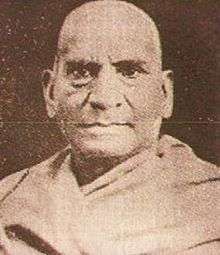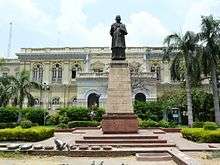Swami Shraddhanand
| Swami Shraddhanand. | |
|---|---|
 | |
| Born |
6 February 1856 Talwan Village, Jalandhar, India |
| Died |
23 December 1926 (aged 70) Delhi, India |
Swami Shraddhanand (1856–1926), also known as Mahatma Munshi Ram Vij , was an Indian educationist and an Arya Samaj missionary who propagated the teachings of Dayananda Saraswati. This included the establishment of educational institutions, like the Gurukul Kangri University, and played a key role on the Sangathan (consolidation and organization) and the Shuddhi (re-conversion), a Hindu reform movement in the 1920s.
Early life and education
He was born on 22 February 1856 in the village of Talwan in the Jalandhar District of the Punjab Province of India. He was the youngest child in the family of Lala Nanak Chand, who was a Police Inspector in the United Provinces (now Uttar Pradesh), then administered by the Honourable East India Company. His given name was Brihaspati Vij, but later he was called Munshi Ram Vij by his father, a name that stayed with him till he took sanyas in 1917, variously as Lala Munshi Ram Vij and Mahatma Munshi Ram.
He adopted atheism after a few incidents, such as when he was prevented from entering the temple while a noble woman was praying. He also was witness to a "compromising" situation involving a church's father with a nun,[1] the attempted rape of a young devotee by pontiffs of the Krishna cult, and the suspicious death of a little girl at the home of a Muslim lawyer. All of these events cemented his atheism. He eventually passed mukhtari exams and began studying to become a lawyer.[1]
Meeting Dayanand
He first met Dayanand Saraswati when Dayanand visited Bareilly to give lectures. His father was handling arrangements and security at the events, due to the attendance of some prominent personalities and British officers. Munshiram attend the lectures at his father's request. He originally went with the intent of spoiling the arrangements, then claimed to be strongly influenced by Dayanand's courage, skill, and strong personality. After completing his studies Munshiram started his practice as lawyer.[1][2]
Career

Schools
In 1892 Arya Samaj was split into two factions after a controversy over whether to make Vedic education the core curriculum at the DAV College Lahore. He left the organization and formed the Punjab Arya Samaj. The Arya Samaj was divided between the Gurukul Section and the DAV Section. Shraddhanand headed for Gurukuls. In 1897, when Lala Lekh Ram was assassinated, Shraddhanand succeeded him. He headed the 'Punjab Arya Pratinidhi Sabha', and started its monthly journal, Arya Musafir.[3] In 1902 he established a Gurukul in Kangri, India near Haridwar. This school is now recognized as Gurukul Kangri University.
In 1917, Mahatma Munshi Ram took sanyas as "Swami Shradhanand Saraswati".
Shraddhanand established gurukul Indraprashtha in Aravali near Faridabad, Haryana.[3]
Activism
In 1917, Shraddhanand left Gurukul to become an active member of the Hindu reform movements and the Indian Independence movement.[2] He began working with the Congress, which he invited to hold its session at Amritsar in 1919. This was because of the Jalianwala massacre, and no one in the Congress Committee agreed to have a session at Amritsar. Shraddhanand presided over the session.
He also joined the nationwide protest against the Rowlatt Act. The same year he protested in front of a posse of Gurkha soldiers at the Clock Tower in Chandni Chowk, then was allowed to proceed.[2] In the early 1920s he emerged as an important force in the Hindu Sangathan (consolidation) movement, which was a by product of the now revitalised Hindu Maha Sabha.[4]
Swami Shradhanand was the only Hindu Sanyasi who addressed a huge gathering from the minarets of the main Jama Masjid New Delhi, for national solidarity and vedic dharma starting his speech with the recitation of ved mantras.[2]
He wrote on religious issues in both Hindi and Urdu. He published newspapers in the two languages as well. He promoted Hindi in the Devanagri script, helped the poor and promoted the education of women. By 1923, he left the social arena and plunged whole-heartedly into his earlier work of the shuddhi movement (re-conversion to Hinduism), which he turned into an important force within Hinduism.[5]
In late 1923, he became the president of Bhartiya Hindu Shuddhi Sabha, created with an aim of reconverting Muslims, specifically 'Malkana Rajputs' in the western United Province. This brought him into direct confrontation with Muslim clerics and leaders of the time.[3][6]
Assassination

On 23 December 1926 he was assassinated by a Muslim named Abdul Rashid,[7] who entered his home at Naya Bazar, Delhi, by posing as a visitor.[8] Upon his death, Gandhi moved a condolence motion at the Guwahati session of the Congress on 25 December 1926.[9] An excerpt from the speech in relevant part reads "If you hold dear the memory of Swami Shraddhanandji, you would help in purging the atmosphere of mutual hatred and calumny. You would help in boycotting papers which foment hatred and spread misrepresentation. I am sure that India would lose nothing if 90 per cent of the papers were to cease today. . . Now you will perhaps understand why I have called Abdul Rashid a brother and I repeat it. I do not even regard him as guilty of Swamiji's murder. Guilty indeed are all those who excited feelings of hatred against one another. For us Hindus the Gita enjoins on us the lesson of equi-mindedness; we are to cherish the same feelings towards a learned Brahman as towards a chandala, a dog, a cow or an elephant." [10]
Today, the 'Swami Shraddhanand Kaksha' at the archeological museum of the Gurukul Kangri University in Haridwar houses a photographic journey of his life.[11]
A statue of him was placed in front of Delhi Town Hall after independence, replacing a statue of Queen Victoria.[12] This location in Old Delhi is termed ghantaghar because the old clock tower stood here until the 1950s.[13]
Personal life
Shraddhanad and his wife Shiwa Devi had two sons and two daughters. His wife died when Shraddhanad was only 35 years old. His granddaughter Satyavati was a prominent opponent of the British rule in India.[14]
Bibliography
- The Arya Samaj and Its Detractors: A Vindication, Rama Deva. Published by s.n, 1910.
- Hindu Sangathan: Saviour of the Dying Race, Published by s.n., 1924.
- Inside Congress, by Swami Shraddhanand, Compiled by Purushottama Rāmacandra Lele. Published by Phoenix Publications, 1946.
- Kalyan Marg Ke Pathik (Autobiography:Hindi), New Delhi. n.d.
- Autobiography (English Translation), Edited by M. R. Jambunathan. Published by Bharatiya Vidya Bhavan, 1961
Further reading
| Wikisource has original text related to this article: |
| Wikisource has original text related to this article: |
- Swami Shraddhanand, by Satyadev Vidyalankar, ed. by Indra Vidyavachaspati. Delhi, 1933.
- Swami Shraddhanand (Lala Munshi Ram), by Aryapathik Lekh Ram. Jallandhar. 2020 Vik.
- Swami Shraddhanand, by K.N. Kapur. Arya Pratinidhi Sabha, Jallandhar, 1978.
- Swami Shraddhanand: His Life and Causes, by J. T. F. Jordens. Published by Oxford University Press, 1981.
- Section Two:Swami Shraddhanand . Modern Indian Political Thought, by Vishwanath Prasad Varma. Published by Lakshmi Narain Agarwal, 1961. Page 447.
- Chapt XI: Swami Shraddhanand. Advanced Study in the History of Modern India : 1920–1947. by G. S. Chhabra. Published by Sterling Publishers, 1971. Page 211
- Pen-portraits and Tributes by Gandhiji: '(Sketches of eminent men and women by Mahatma Gandhi)', by Gandhi, U. S. Mohan Rao. Published by National Book Trust, India, 1969. Page 133
- Swami Shraddhanand – Indian freedom fighters: struggle for independence. Anmol Publishers, 1996. ISBN 81-7488-268-5.
- Telegram to Swami Shraddhanand, (2 October 1919) – Collected Works, by Gandhi. Published by Publications Division, Ministry of Information and Broadcasting, Govt. of India, 1958. v.16. Page 203.
- An article on Swami Shraddhanand in "The Legacy of The Punjab" by R M Chopra, 1997, Punjabee Bradree, Calcutta,
References
- 1 2 3 Autobiography http://www.vedpedia.com Archived 2 February 2011 at the Wayback Machine.
- 1 2 3 4 G.S. Chhatra. Some Indian Personalities of the Time: Swami Shraddhanand Advanced Study in the History of Modern India Lotus Press. 2007. ISBN 81-89093-08-8 p. 227.
- 1 2 3 G. R. Thursby. Controversy Hindu-Muslim Relations in British India: A Study of Controversy, Conflict, and Communal Movements in Northern India 1923–1928, BRILL, 1975. ISBN 90-04-04380-2. p. 15.
- ↑ Chetan Bhatt. Shraddhanand Hindu Nationalism: Origins, Ideologies and Modern Myths Berg Publishers, 2001. ISBN 1-85973-348-4. p. 62
- ↑ R. K. Ghai. Shuddhi Movement in India: A Study of Its Socio-political Dimensions, Commonwealth Publishers, 1990. p. 43.
- ↑ Kenneth W. Jones. Socio-Religious Reform Movements in British India: Socio-Religious Reform Movements in British India, Volume III-1 Cambridge University Press, 1987. ISBN 0-521-24986-4. p. 194
- ↑ Joseph Lelyveld. Great Soul: Mahatma Gandhi and His Struggle with India, Knopf, 2011, pp. 171-172
- ↑ 23 December is the Shardanand Balidhan Divas Arya Samaj.
- ↑ Jagdish Saran Sharma. Indian National Congress: A Descriptive Bibliography of India's Struggle for Freedom, S. Chand, 1959. p. 502.
- ↑ http://www.mahatma.org.in/mahatma/books/showbook.jsp?id=17&link=bg&book=bg0013&lang=en&cat=books
- ↑ Archaeological Museum Gurukul Kangri University
- ↑ "Stories in stone", The Hindu, 20 October 2014
- ↑ Clock Tower Chandni Chowk, Delhi, early 1900s
- ↑ Forbes, Geraldine (28 April 1999). Women in Modern India, Volume 4. Cambridge University Press. p. 148.